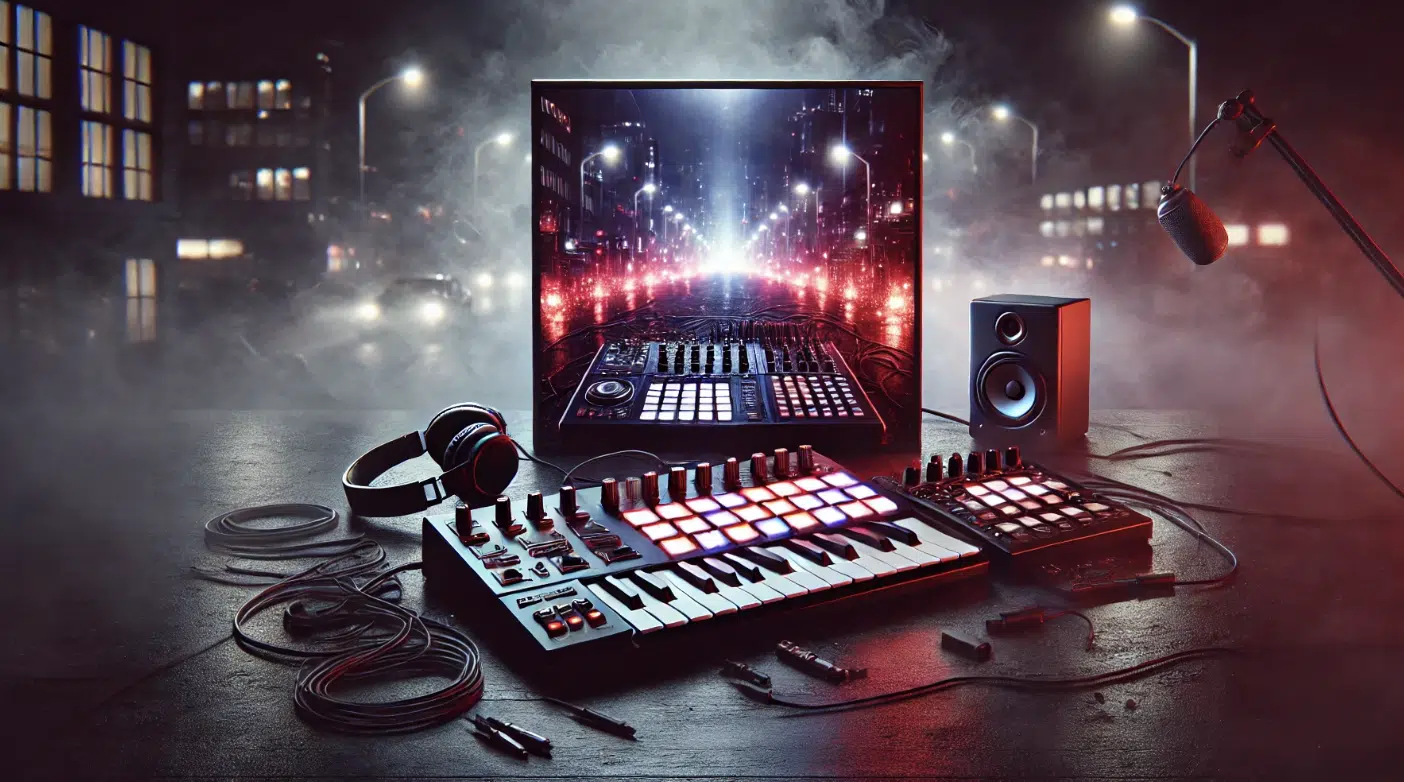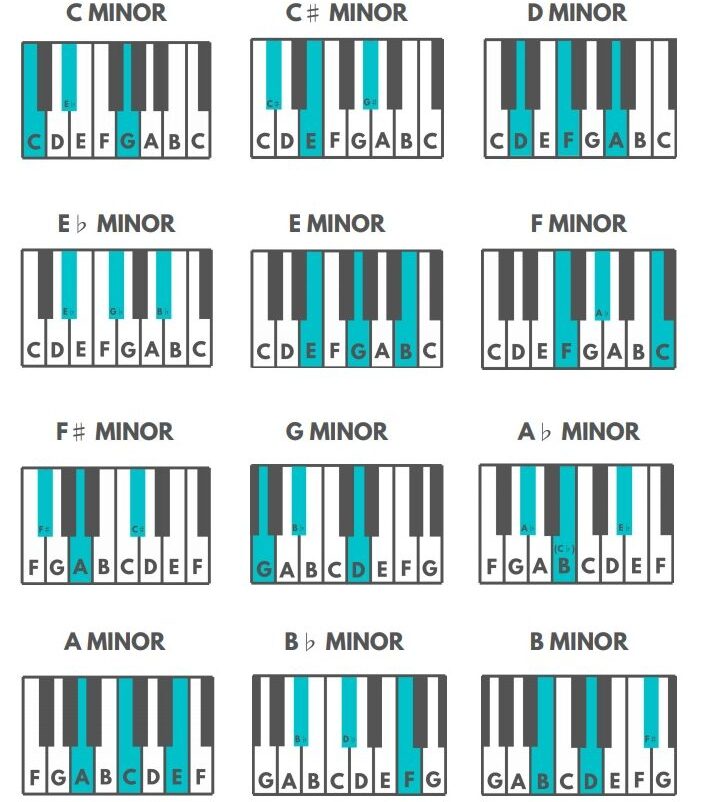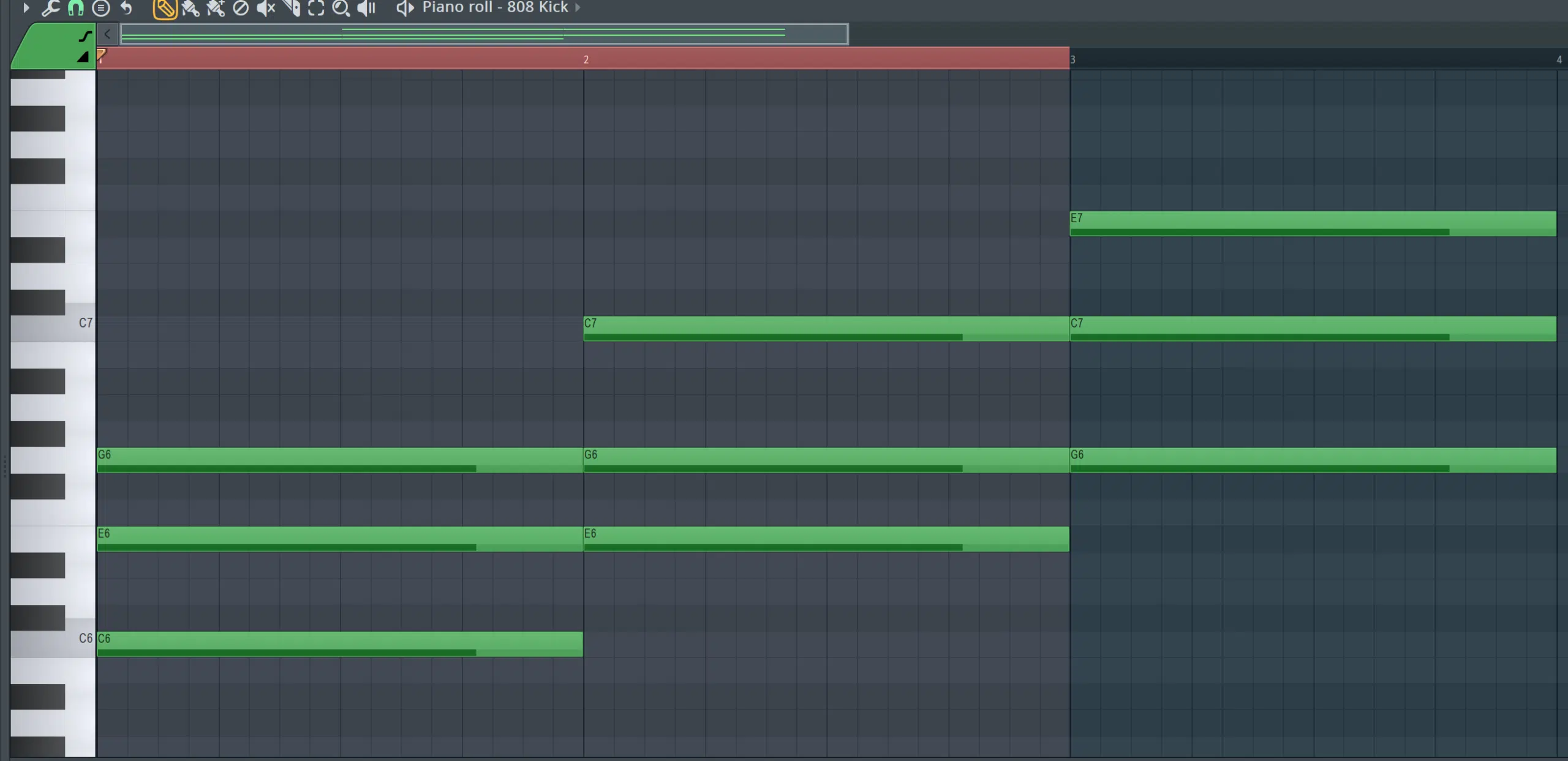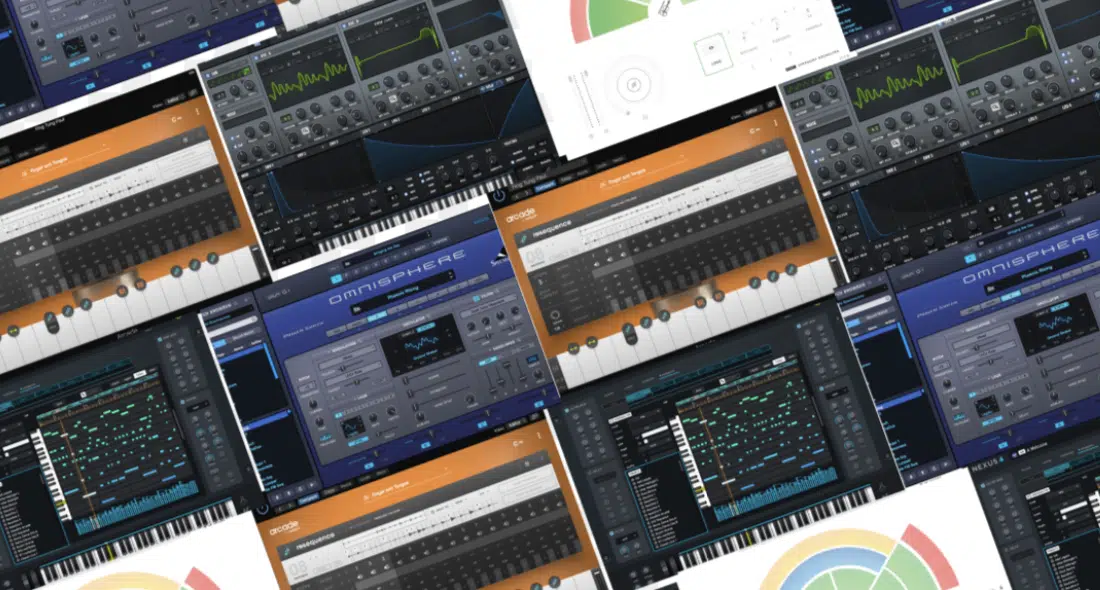Drill chords are all about creating dark, emotional tension and bringing powerful, hard-hitting vibes to the table.
They bring serious depth and grit 一 making them super intriguing for listeners who want to hear that infamous drill edge.
As producers, it’s important to know everything about how these chords work and how to use them creatively in your own tracks.
That’s why we’re breaking it all down today so you can get the full picture and start knocking out hard-hitting productions.
In today’s article we’ll cover things like:
- The essence of drill music and its unique sound ✓
- Minor chords and why they’re the foundation ✓
- How diminished chords add tension and darkness ✓
- Using inversions & voicings for more dynamic tracks ✓
- Building dark chord progressions like a pro ✓
- Matching chords with basslines and 808s ✓
- Adding melodic elements and haunting counter-melodies ✓
- Applying effects and processing for a polished sound ✓
- Pro tips/techniques for arranging drill tracks ✓
- How to make sure your tracks are full of power ✓
- Much more about drill music & drill chords ✓
By knowing all about drill chords, you’ll be able to create haunting atmospheres, dramatic builds, and tension-filled drops to blow minds.
Plus, you’ll successfully layer melodies, structure tracks with precision, and bring a professional polish to every beat.
This way, your drill tracks will seriously stand out with the gritty, emotional vibe of drill music fans everywhere (and dominate the competition).
Table of Contents
- The Essence of Drill Chords: Breaking it Down
- Key Music Theory for Drill Chords
- Creating Dark Drill Chords
- Using Inversions and Voicings
- Chords with Basslines and 808s
- Adding Melodic Elements and Counter-Melodies
- Applying Effects and Processing
- Bonus: Advanced Tips/Techniques for Creating Drill Chords
- Final Thoughts
The Essence of Drill Chords: Breaking it Down

Drill music is built on dark, emotional tones that instantly grab the listener’s attention.
And drill chords are all about:
- Minor chords
- Simple yet powerful progressions
- Haunting melodies that create the signature drill vibe
These elements come together with hard-hitting 808s and a rhythmic groove to create tracks that feel both gritty and hypnotic.
In my opinion, a great place to start is by playing around with just two chords, like C minor and Ab major, and layering them with atmospheric instruments.
This could be pianos or strings to hype up the mood.
The simplicity of these chord progressions lets you focus on building tension and enhancing the overall sound, which is what it’s all about.
Don’t worry, we’ll break it all down/explain everything so you get the full picture.
Key Music Theory for Drill Chords

To create authentic drill chords, start with minor chords because they’re the foundation of that dark and emotional sound you’re aiming for.
For example, in C minor, the notes are C, Eb, and G.
These notes naturally create a sadder feel, which is why minor chords are so insanely common in drill tracks.
You can deepen the tension even by throwing in some diminished chords like B diminished (B, D, F), which introduce an unsettling, edgy vibe.
Pairing a C minor chord with Ab major (Ab, C, Eb) creates a smooth yet dramatic progression, while diminished chords can act as transitions between your main chords.
The shared C and Eb notes make the transition between these chords feel natural and effortless.
The move from the darker tones of C minor to the slightly brighter Ab major, on the other hand, creates a compelling contrast.
This type of progression works perfectly in intros, breakdowns, or even as the foundation of a hook (depending on how it’s voiced and arranged, of course).
Also, try playing around with your MIDI keyboard to shift one note at a time 一 for example lowering the G in C minor to F# transforms it into C diminished.
Start by playing the C minor chord, and then lower the G down to F# to transform it into C diminished.
Then, take note of how the F# introduces a dissonance that feels unresolved until you land on Ab major; this is key.
NOTE: For added texture, layer the diminished chord with a reversed piano sample or a soft pad to emphasize its sick, suspenseful nature.
It adds just the right amount of tension for your drill tracks.
-
Pro Tip: Selecting the Right Sounds and Instruments

When creating drill chords, the right sounds and instruments are key for setting the tone, otherwise you won’t get the vibe just right.
Pianos are the basis for many drill tracks, with soft, felt piano samples giving a raw, emotional feel, while electric pianos like the Rhodes add a smoother texture.
Strings, such as cellos and violins, bring an eerie cinematic quality, especially when layered with detuned bells or pads.
NOTE: Use low-pass filters to roll off the high frequencies and let the darkness take center stage, because that’s what it’s all about (don’t forget that).
Adding subtle reverb and delay can enhance the space around your chords 一 making them feel expansive, dramatic, and full of power.
It’s almost a rule of thumb when dealing with drill chords.
Side note, if you’re looking for the ultimate drill beatmaker pack, we got you covered.
Creating Dark Drill Chords
Dark chord progressions give drill tracks their signature emotional depth and tension as we just talked about. So, for this next section, let’s dive into the top drill chords so you can see exactly how minor and diminished chords come together to create some really unforgettable moments.
-
C minor – Ab major

The C minor (C, Eb, G) to Ab major (Ab, C, Eb) progression is a classic drill chord pairing because it balances dark, melancholic tones with a subtle sense of resolution.
C minor lays the foundation with a haunting and emotional vibe, driven by the flattened third (Eb) that gives minor chords their moody character.
Ab major, with its brighter tones, acts as a contrast 一 softening the chord progression just enough to keep the listener engaged.
To make this chord progression more dynamic, try arpeggiating the C minor chord by playing C, Eb, and G in a rolling pattern while sustaining the Ab major as a block chord.
PRO TIP: Layer your chords with a low-octave piano and add a detuned bell melody above them to create texture.
If you want to enhance the flow, add a subtle 808 bassline that alternates between C and Ab, which gives the chord progression a super powerful low-end.
-
Ab minor 7 – Eb7sus2 – Eb minor

Ab minor 7 (Ab, Cb, Eb, Gb) to Eb7sus2 (Eb, F, Ab, Bb) to Eb minor (Eb, Gb, Bb) creates a sick, layered progression that combines darkness with tension and resolution.
The Ab minor 7 chord sets a rich, moody tone with its added seventh (Gb) 一 making it sound more complex than a basic minor triad.
Eb7sus2, with its suspended second (Bb), introduces a feeling of suspense and anticipation (almost like the track is holding its breath).
The final Eb minor chord brings everything back to a grounded, dark resolution for the perfect conclusion.
NOTE: For a more cinematic feel, use a string ensemble to play the Ab minor 7 softly, then accentuate the tension on Eb7sus2 by adding a tremolo effect.
To finish things off, resolve into Eb minor with a heavy 808 drop that matches the root note for a dramatic payoff that’s full of power.
This chord progression works perfectly in breakdowns or intros when you want to create emotional depth.
-
Eb minor – Ab minor

Eb minor (Eb, Gb, Bb) to Ab minor (Ab, Cb, Eb) is a smooth, cohesive chord progression perfect for sections where you want to build intensity without dramatic shifts.
The shared Eb note between the two chords makes transitions show-stopping, while the movement from Eb minor to Ab minor creates a subtle lift of emotions.
Simply play the Eb minor chord in its root position, then invert the Ab minor chord by placing Cb in the bass for a fuller sound.
Adding rhythmic variation can make this progression stand out…
For example, play the Eb minor chord in a syncopated rhythm while holding the Ab minor as a sustained chord.
You can even enhance the chord progression by layering it with a dark pad and using a reversed piano melody to add texture/dark mystery.
This combination is absolutely perfect for creating tension in verses or building anticipation before a major, mind-blowing drop.
If you want an example of a song in which the drill chords share, just listen to the songs J.Cole’s ‘Middle Child’ or “Love Sosa.”
-
G minor – F major – Eb major

The chord progression G minor (G, Bb, D) to F major (F, A, C) and finally to Eb major (Eb, G, Bb) creates a blend of tension and resolution.
G minor introduces a sense of intrigue and darkness, setting the tone for the progression.
Moving to F major brightens things up just slightly.
It basically acts as a transitional chord that prepares the listener for the final Eb major chord, which feels both grounded and melodic at the same time.
To make this progression really pop, try layering the G minor and Eb major chords with a soft piano, and let the F major chord stand out with a detuned synth for contrast.
Don’t forget to experiment with a rolling arpeggio on G minor to create movement, while sustaining the Eb major for an emotional finish.
-
Eb minor – D diminished – F diminished – Eb minor

Eb minor (Eb, Gb, Bb) to D diminished (D, F, Ab) introduces an immediate sense of unease, which is hyped up even more when transitioning to F diminished (F, Ab, Cb).
Returning to Eb minor brings the chord progression full circle, resolving the tension created by the diminished chords.
Diminished chords (like D diminished and F diminished) are super effective in drill music because of their dissonant sound, which keeps the listener on edge.
Remember, when you’re laying down drill chords, it’s all about tension, tension, tension.
Enhance this chord progression by playing the Eb minor chords with a full sustain, while using staccato hits for the diminished chords to emphasize the tension.
A subtle touch of reverb can smooth the transitions and give the diminished chords an ethereal quality.
Using Inversions and Voicings

Inversions and voicings are all about reshaping the emotional tone of your drill chords while keeping the progression fresh, engaging, and beautifully dark.
Inversions are variations of a chord where you rearrange the order of the notes.
For example, instead of playing C minor (C, Eb, G) in its root position, try the first inversion (Eb, G, C) to create a smoother transition to Ab major or Ab minor.
Voicings, on the other hand, are about how you distribute the notes of a chord across octaves or instruments, so definitely play around with that as well.
Drill tracks can get taken up a notch by spreading notes across different octaves…
What you’ll want to do is play the root note (C) in the bass and the remaining notes higher up to give your chord progression depth and weight.
Another trick is to use open voicings by skipping certain chord tones and spreading them out, like playing only C and G in C minor while letting the melody fill in the Eb.
To add tension, try stacking dissonant intervals 一 play a G and F# in the same inversion for a slight clash that resolves when you switch chords.
Just remember that the key is balance. Too much dissonance can overwhelm the track, so always contrast it with moments of resolution to keep the flow on point.
Again, use a MIDI keyboard to experiment with different voicings and inversions until you find the combination that feels right for your track.
Chords with Basslines and 808s

Your basslines and 808s should always compliment your drill chords, reinforcing their emotional weight and driving the rhythm.
Start by matching the root notes of your chords with your 808s.
For example, if your chord progression is Eb minor to Ab minor, program your 808 to hit Eb and Ab.
This keeps your bassline grounded and aligned with the harmonic structure of the track. For even more impact, let the 808 follow the rhythm of the chord changes.
But, feel free to add variations to keep it dynamic. I’m all about creative experimentation, and I hope you are as well.
To add depth, experiment with pitch slides like sliding from Eb down to Bb on the 808 to create a dramatic drop that feels crazy powerful.
For instance, sliding from Eb down to Bb on the 808 creates a dramatic drop that feels extremely powerful and emotive.
Use your DAW’s glide settings or pitch automation to make the transition smooth and impactful:
- A slow pitch slide can build tension.
- A quick drop can make your bassline hit even harder.
Layering your bassline with a sub-bass synth can further blow up the low-end while leaving room for the chords and melody.
A sub-bass focused on pure sine waves is a great choice 一 it fills out the very lowest frequencies without overpowering the mix, which you never want.
Then, add some subtle saturation or distortion to the 808 for a grittier sound that still cuts through.
Just make sure to keep your 808s clean and punchy by applying a high-pass filter to your chords.
Roll off anything below 100 Hz from your pianos, pads, or other harmonic elements to make ample space for the bass.
This way, the bass dominates the lower frequencies without competition (you’ll hear it sounds much better right off rip).
Adding Melodic Elements and Counter-Melodies

Melodic elements and counter-melodies are what give drill tracks/drill chords their haunting and hypnotic character.
Start with a simple melody in the same key as your chords like, if you’re working with C minor, use notes like C, Eb, and G to lay down a memorable line.
For example, a descending melody like G to Eb to C, played with a piano or bell sound, can instantly add a dark, introspective vibe.
Counter-melodies add depth by contrasting the main melody.
A great trick is to isolate one note from your chords and repeat it with slight rhythmic or pitch variations.
For example, if your progression includes Ab minor, try using the note Cb in your counter-melody and experiment with syncopated rhythms.
This works super well with detuned synths or vocal chops.
If you’re just beginning to play around with drill music, don’t overlook counter-melodies because it would be a mistake to do so, honestly.
Adding effects like delay or reverb to your melodies can make them feel even more atmospheric, while panning them slightly left or right enhances the stereo field.
NOTE: Use a quarter-note delay with a touch of feedback to create a subtle echo, or try a plate reverb for a vintage, eerie quality that’s pretty cool.
Just don’t forget to always think about how your melodies interact with the chords and bassline to keep your track cohesive and captivating.
Applying Effects and Processing

Effects and processing are essential for enhancing your drill chords and giving them that polished, professional sound.
Plus, they’re just straight up fun to play around with.
Start with reverb to add space and depth 一 use a medium-sized hall reverb for pianos to create a cinematic feel or a plate reverb on strings for a vintage edge.
For strings, try using a plate reverb to give them a vintage edge, which is perfect for a haunting, old-school vibe.
Adjust the decay time carefully because too long, and your mix might feel muddy, while too short can leave it sounding dry.
Delay is another key effect, so try a quarter-note delay with a low feedback setting to make your melody echo subtly without overpowering the chords.
For a more intricate feel, try adding a ping-pong delay, which alternates the echo between the left and right channels so the track feels wider and more immersive.
This works great on bell melodies or high-pitched vocal chops.
For added texture, experiment with distortion or saturation on your pads or synths; just a little bit of drive can give your chords weight, grit, and darkness.
If you’re using a soft piano, slightly saturate the low mids to bring out warmth and make the chords cut through the mix (be careful here as well and don’t overdo it).
Don’t forget EQ… Cut unnecessary low frequencies from your chords to make room for the 808 and bassline while boosting the high mids to bring clarity to the melody.
Start with a high-pass filter around 100 Hz and adjust as needed.
Boost the high mids (around 2-5 kHz) to bring clarity to the melody, especially if you’ve layered multiple instruments, which you probably will.
One of my favorite tricks (and my advice to you) is automating a low-pass filter to sweep across the chords during transitions.
Set the filter cutoff to gradually rise or fall, and pair it with a subtle reverb tail to create smooth, cinematic intrigue.
It will add extra movement and keep your listener hooked from start to finish.
Bonus: Advanced Tips/Techniques for Creating Drill Chords

Now that you know all about drill chords and all the different ways you can get super creative, let’s break down some of my favorite advanced tips.
They’ll help you get even more crazy so your drill chords (and drill beats in general) sound crazy professional and intriguing.
1. Layering Different Sounds
Combine multiple instruments for epic drill chords you’ll hear right away. For example, layer a soft piano with a detuned synth and a low cello pad to create a dark, full-bodied sound. Use EQ to carve out space for each layer so they don’t muddy the mix.
2. Adding Ghost Notes
Play subtle ghost notes, like tapping the F# between Eb and G in Eb minor, to add rhythmic interest. These notes aren’t part of the main chord progression but create movement, control, and help fill the space.
3. Reverse Melodies
Reverse your chords or melody using your DAW’s audio editing tools for an eerie, hypnotic effect. Pair this with a stretched-out reverb tail for a haunting texture and you’re golden.
4. Rhythmic Variations
Break up your chord progression by altering the rhythm. Instead of sustaining the chords, try playing the C minor chord in a syncopated rhythm to keep the track feeling fresh and dynamic.
5. Experimenting with Diminished Chords
Use diminished chords like B diminished (B, D, F) as transitions between minor chords. For example, play B diminished between C minor and Ab major to add tension and create a flawless flow. It might take a little practice and time to learn, but you should master it pretty quickly.
6. Stereo Width Automation
Use a stereo imaging plugin to automate the width of your chords. Keep them narrow during the verse and expand them in the chorus for a dramatic, full sound. This technique works wonders when mixed with a wide pad or atmospheric effect.
7. Pitch Modulation
Add slight pitch bends to individual notes in your relative chords using your MIDI keyboard’s pitch wheel or automation (think hip-hop). For example, bending the G in G minor up to Ab can create a sense of tension before resolving to the next chord.
These small details make a huge difference in keeping your drill chords engaging, dark, and unique, which is what you should always be aiming for.
Final Thoughts

And there you have it: everything you need to know about drill chords.
Remember, drill chords are all about creating dark, emotional tension for hypnotic melodies, and delivering hard-hitting vibes that define drill tracks.
Plus, they give you the flexibility to play around with inversions, voicings, and effects to make your sound truly unique.
With the information, tips, and techniques you’ve learned today, you’ll be knocking out sick drill beats in no time.
Just keep things balanced, and make sure every element (from your chords to your 808s) works together flawlessly.
And, as a special bonus, you’ve got to check out this legendary Free Drill Sample Pack that’s taking over right now.
It includes 60+ free drill samples, loops, and MIDIs that can completely transform your beats from basic to mind-blowing.
These proper, polished, perfectly processed samples were all created by expert beatmakers, sound designers, and mixing engineers, so you’re getting serious quality.
Plus, they’re all modeled off the styles of the biggest artists in modern music like Pop Smoke, CJ, Stormzy, and more.
And yes, everything is 100% royalty-free, so feel free to use them however you’d like.
Bottom line, drill chords can transform your tracks, giving them depth, emotion, and that unmistakable edge people really look for.
If you follow the steps we talked about today, you’ll be able to produce music that hits hard and connects with listeners on a deep level, plus your drill chords will be super clean.
Just keep in mind you never want to rush the process 一 take your time, experiment fearlessly, and think outside the box (nothing is too crazy).
Until next time…







Leave a Reply
You must belogged in to post a comment.